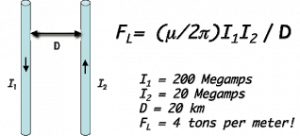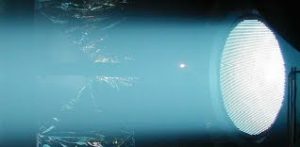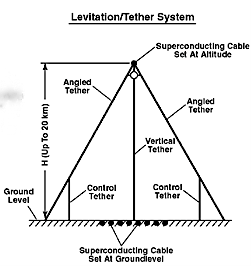Startram is a mass driver, which means it requires neither rockets nor propellant to launch payload into space. Mass drivers are not a new concept. Early mass drivers were envisioned in fiction in the late nineteenth century, and have been a staple of speculative fiction ever since. Various engineering concepts of the mass driver have been described over the years, but no significant progress towards building a mass driver has been made due to large technical hurdles.
We believe that Startram is the first mass driver design that combines available technology with intelligent implementation of basic physical principles to yield a design that is actually commercially feasible.
There are two proposed configurations of Startram, Generation-1 and Generation-2. Gen-1 Startram is a cargo-only version which does not require levitated tubes (but instead is built up the flank of a tall mountain) and could be built within ten years at a cost of $20 Billion. Gen-2 Startram is a people-capable version which does require levitated tubes and could be built within twenty years at a cost of $60 Billion.
The key technologies enabling Startram are as follows.
Maglev for Acceleration of Launch Vehicles
 Maglev is an existing technology in use in several countries around the world today. The Japanese maglev program shown here is a superconducting maglev system which has evolved from the original designs of Drs. James Powell and Gordon Danby. The MLX01 vehicle test track has carried tens of thousands of passengers for many years without accident or incident. Currently, maglev transport vehicles routinely run faster than 500 km/h. The main impediment to running maglev much faster is friction caused by air drag. If maglev is placed in evacuated tubes with very low air pressures, it is possible to run maglev at 1000s of km/h. In fact, Chinese companies have already announced that they are planning this.
Maglev is an existing technology in use in several countries around the world today. The Japanese maglev program shown here is a superconducting maglev system which has evolved from the original designs of Drs. James Powell and Gordon Danby. The MLX01 vehicle test track has carried tens of thousands of passengers for many years without accident or incident. Currently, maglev transport vehicles routinely run faster than 500 km/h. The main impediment to running maglev much faster is friction caused by air drag. If maglev is placed in evacuated tubes with very low air pressures, it is possible to run maglev at 1000s of km/h. In fact, Chinese companies have already announced that they are planning this.
Magnetically Suspended Superconducting Cables
 It’s easy to levitate objects electromagnetically. If you push enough current through two conductors in opposite directions, the conductors will be subject to a force pushing them apart. The more current the greater the force. With the advent of superconducting cables being developed for superconducting power grids, it is now possible to construct cables which can carry hundreds of megamps of current. These amperages are sufficient to supply a levitating force of 4 tons per meter of startram guideway, even when the conductors are separated by 20km.
It’s easy to levitate objects electromagnetically. If you push enough current through two conductors in opposite directions, the conductors will be subject to a force pushing them apart. The more current the greater the force. With the advent of superconducting cables being developed for superconducting power grids, it is now possible to construct cables which can carry hundreds of megamps of current. These amperages are sufficient to supply a levitating force of 4 tons per meter of startram guideway, even when the conductors are separated by 20km.
Magneto Hydrodynamic (MHD) Pumps
 MHD applications such as pumps, generators and thrusters have been used for decades. The Startram system uses a “MHD Window” which allows one end of the launch tube to be open the atmosphere, thus permitting launch of the vehicle. Normally, atmospheric gases would immediately fill up the tube and the launch vehicle would be subject to extreme heating and stresses associated with traveling 8km/sec in air. However, the MHD window allows ionized gasses to be continually expelled from the tube, thus maintaining a near-vacuum in the zat all times.
MHD applications such as pumps, generators and thrusters have been used for decades. The Startram system uses a “MHD Window” which allows one end of the launch tube to be open the atmosphere, thus permitting launch of the vehicle. Normally, atmospheric gases would immediately fill up the tube and the launch vehicle would be subject to extreme heating and stresses associated with traveling 8km/sec in air. However, the MHD window allows ionized gasses to be continually expelled from the tube, thus maintaining a near-vacuum in the zat all times.
High-strength Structural Tethers
 One of the challenges of the Space Elevator concept is to engineer tethers that have breaking lengths (i.e. the length of tether can attain before it breaks under its own weight) of thousands of kilometers.
One of the challenges of the Space Elevator concept is to engineer tethers that have breaking lengths (i.e. the length of tether can attain before it breaks under its own weight) of thousands of kilometers.
Startram tethers, in contrast, needs tethers with breaking lengths of only tens of kilometers, which is well within the specifications of modern fibers.
